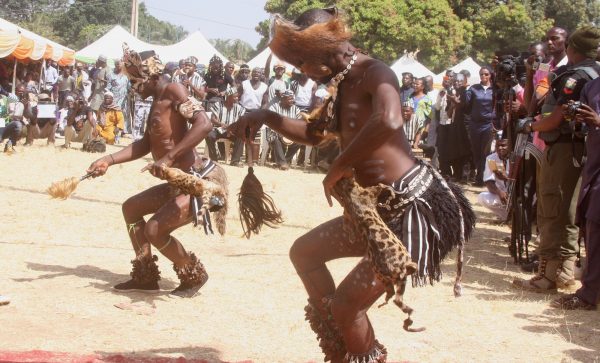The Kagoro people can be found in modern-day Kaduna state. It is believed that their ancestors fled from the Plateau to escape war, moving to the Kagoro rock by way of Assop and Nimbio in the Plateau Province. At Nimbio their food supply was coco-yam, acha (Digitaria Exilis), red sorrel, and inferior yam.
Read more about Ethnic groups in Nigeria
They left Nimbio to save their few remaining dogs and goats from the leopards there and moved to a site known as Tsuwak Busa nearer Kagoro. From Tsuwak Busa, they moved on to the Kagoro Rock at the eastern end near Zafan and spread westward as the population increased.
The men of Zafan whose chief shrine, the Titrak, stands far in the mountain say that while on the rock, the Kagoro split into three divisions Zafan, Mingic and Atswan. The elders of Zafan being descendants of Yaburap in the sixth generation today. A skeleton list of the principal ancestors of Zafan dates the Kagoro occupation of the rock back to approximately 1700 A.D
Sometime later the Kagoro attempted to settle at the northern base of the rock in their present position. The plain was then occupied by the Kacicere serfs of the Kajuru Habe, and the Kagoro were unable to drive them out unaided.
An agreement was reached with the Ganawuri to the East and the Kacicere or Tacherak as they are called in the Kagoro language were then cleared out of the area, which was occupied by Ganawuri in the East, and Kagoro in the West. Later, when a dispute over hunting led to fighting between Kagoro and Ganawuri, an agreement was reached setting the boundary of Kagoro Country on a certain stream.
Socio-Cultural Outlook
Women formerly went naked except for a girdle of leaves and lumber ornament, the maragwadi, men originally wore loin-cloths.
Environment/Socio-Economic Outlook
The Kagoro massif has a height of over 4,000 feet and rises 2,000 feet above the surrounding land. At the top are an unfailing freshwater supply and arable land sufficient for the farms of the original Kagoro who settled there. Today the rock is mainly useful as a source of wood and water.
Sign up to the Connect Nigeria daily newsletter
The Kagoro are primarily agriculturists but hunting was an important economic activity in former days when large fauna was abundant. Domestic animals reared for meat traditionally were dogs, goats and chickens; pig-breeding introduced recently is undertaken mainly for sale to Jos and across Igboland, and, to a lesser extent, for local food.
The soil is mostly dark loam. Rainfall is also much heavy, at an average of over 60 inches a year. The climate well supports the people’s agricultural activities enabling the cultivation of crops such as; Elcusine millet, sorghum, maize, acha (Digitaria exilis), and more recently, rice, coco-yams, cassava, sweet potatoes.
Beans of two sorts are traditionally farmed by women. Benniseed, pepper, tobacco and wet-season groundnuts are other important crops. Although, trees for fuel are scarce in the area, economic trees like oil palm. Locust bean, raffia palm and mahogany abound.
Socio-Political Structure
Chieftainship and the history of chieftainship in Kagoro are products of culture contact. Originating from situations involving Kagoro and the Muhammadan Hausa-Fulani emirates and more recently the British.
Knowledge of Kagoro culture and social organisation makes it very difficult to believe that Kagoro had chiefs of any kind or clan before 1905. All the normal administrative functions of chieftainship were fulfilled by other ritual and social institutions.
But of more recent times, the Kagoro people have a first-class Chief who goes by the title “Agwam Oegworok”.
The Marriage System
The following are the three principal types ·of marriage traditionally practised by the Kagoro;
(1). Primary marriage by betrothal (TIN EBIUK).
(2) Widow Inheritance (a) of a man’s father’s wife (SAK AYANG)
(b) of a man’s· “real brother’s wife (DAK EBIUK)
(c) of a classificatory brother’s wife (ASHINGUO)
(3) Secondary Marriage (a) by the elopement of a wife (TSWO EBIUK)
(b) by forcible capture of a wife (KWAK EBIUK)
The Kagoro Afan National Festival
Famous among the natives as ‘Chika Aelio‘, is one of the most glamorous cultural festivals in Kaduna State and perhaps Northern Nigeria as a whole.
This festival is celebrated every first day of January by the Kagoro people. Afan means mountain or hill and the festival’s original intent was to mark the end of the annual grains harvest and the onset of the hunting expeditions.
The hills are of great significance to the Kagoro people as they share a common belief that they protected them from their adversaries in the olden days.
Religious Beliefs
Prior to the arrival of the British colonial masters, the Kagoro people were a pagan traditional idol-worshipping group. The Aboi male cults played an important role in their communal life before the advent of Christianity in the area.
Source:
Wikipedia
G. Smith, Social organization and economy in Kagoro, 1975
Featured Image Source:
Got a suggestion? Contact us: [email protected]


